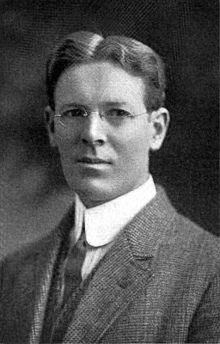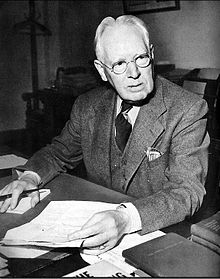James A. Johnston
James A. Johnston | |
|---|---|
 | |
| Warden of Alcatraz Federal Penitentiary | |
| In office 1934–1948 | |
| Preceded by | Prison opened |
| Succeeded by | Edwin B. Swope |
| Warden of San Quentin State Prison | |
| In office 1914–1924 | |
| Warden of Folsom State Prison | |
| In office 1912–1913 | |
| Member of the San Francisco Board of Supervisors | |
| In office 1907–1909 | |
| Preceded by | Eusebius Joseph Molera |
| Succeeded by | John L. Herget |
| Personal details | |
| Born | James Aloysius Johnston September 15, 1874 City of Brooklyn, New York |
| Died | September 7, 1954 (aged 79) San Francisco, California |
| Spouse |
Ida Mae Fulton (m. 1905) |
| Children | 5 |
| Occupation | Politician Prison warden Writer |
James Aloysius Johnston (September 15, 1874 – September 7, 1954) was an American politician and prison warden who served as the first and longest-serving warden of Alcatraz Federal Penitentiary, serving from 1934 to 1948. He had earlier served as wardens of California state prisons at Folsom (1912-1913) and San Quentin (1914-1924).
Biography
[edit]Born in Brooklyn, New York and orphaned at the age of ten, Johnston began working at age fifteen in a clothing store at Weinstock, Lubin and Company in Sacramento, California. He sold neckties in the menswear department. He rose to General Manager of Weinstock Lubin.
After moving to San Francisco, he started his own store, Johnston's Men's Wear, at 916 Market Street.
Entering politics in the young city, he was elected to the San Francisco Board of Supervisors in 1907. In 1911 he was appointed to the California State Board of Control, headed by new gubernatorial appointee John Francis Neylan. The state legislature had given the board "centralized control of the financial outlays of most state agencies."[1] [citation needed]
The next year Johnston was appointed to serve as warden of the state prison at Folsom State Prison (1912-1913), followed by serving a decade as warden at San Quentin (1914-1924) (see caption of image of Johnston).[2] He became known for his focus on redeeming offenders and work to improve their lives; for instance, he treated those who needed it for drug abuse, and established educational and employment programs for inmates. In 1912 the state hired its first dentists to treat prisoners.[2]
Johnston was considered to be both a strict disciplinarian and devout reformist. His rules included a strict code of silence, and he was nicknamed the 'Golden Rule Warden' while at San Quentin. He was relatively popular among inmates and guards, and also became known as "Old Saltwater". He is credited with challenging some of the harsh tactics used in the prison, including strait jackets and solitary confinement in darkness. He worked to improve the lives of prisoners.

Based on this experience, Johnston was instrumental in the conversion and adaptation of Alcatraz Federal Penitentiary from its military use to serve as a federal prison. He was involved in its design in 1934.[citation needed] He served as the first warden of Alcatraz, from 1934 until 1948. He had the longest term of service of any succeeding warden.
In 1937 he was assaulted by Burton Phillips in the Dining hall, where he customarily ate with the prisoners and was unguarded. Phillips, convicted of robbery and kidnapping, allegedly beat the warden in anger at a worker's strike. Johnston did not let this incident deter him, and returned to attending meals unguarded in the Dining Hall.[citation needed]
Ten of the fourteen escape attempts from Alcatraz took place during Johnston's tenure,[citation needed]. These included what is called the Battle of Alcatraz from May 2–4, 1946, when Marines were finally called in to supplement prison guards in suppressing an escape attempt and related violence. Two Bureau of Prison guards were killed, as were three of the prisoners attempting escape. Others were wounded.

Personal life
[edit]Johnston wrote several memoirs, including Prison Life is Different (1937, published by Houghton Mifflin). He documented his service as warden at Folsom, San Quentin, and Alcatraz.
He married Ida Mae Fulton on November 7, 1905, with whom he had a son and three daughters.[3]
Johnston died of a bronchial infection on September 7, 1954, in San Francisco, California.
References
[edit]- ^ "Here is a chance to stop waste of public money". Santa Ana Register. San Francisco Bulletin. March 18, 1911 – via Newspapers.com.
- ^ a b "1914: San Quentin warden focuses on redeeming offenders". California Department of Corrections and Rehabilitation. 14 June 2018. Retrieved 27 September 2021.
- ^ Johnston, James A. (1949). Alcatraz Island Prison. New York City: C. Scribner's Sons. (Reissued in paperback in 2012 as Alcatraz Island Prison and the Men Who Live There, by Read Books, ISBN 1447450213).
Further reading
[edit]- Ward, David A.; Kassebaum, Gene G. (19 May 2009). Alcatraz: The Gangster Years. University of California Press. ISBN 978-0-520-25607-1. Retrieved 8 September 2012.
- Wellman, Gregory L. (28 May 2008). A History of Alcatraz Island:: 1853-2008. Arcadia Publishing. ISBN 978-0-7385-5815-8. Retrieved 8 September 2012.
- Lewis Champion Jr, Jerry (27 January 2011). The Fading Voices of Alcatraz. AuthorHouse. p. 106. ISBN 978-1-4567-1487-1. Retrieved 7 September 2012. (self-published book, not RS)

